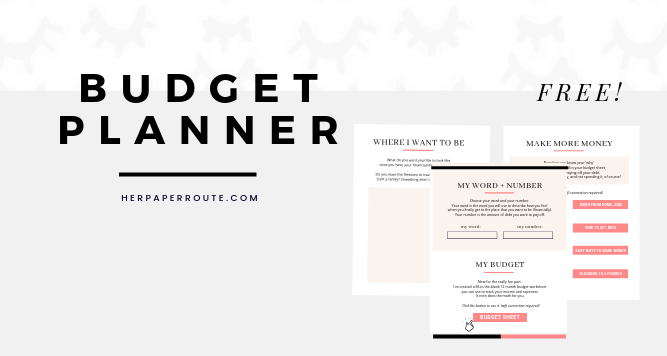How To Create A Budget – 12 Easy Steps

Today you are going to learn how to create a budget. Navigating the world of personal finance can often seem like a complex puzzle, but with the right approach, it becomes much simpler.
In this guide, we’ll break down the budgeting process into manageable and clear segments, making it an achievable task for anyone.
As an affiliate partner of various brands and sponsored content, HerPaperRoute may earn commission on qualifying purchases. Disclaimer
If you are trying to enter your rich girl era, the first step is to know your numbers. So you are on the right track by reading HerPaperRoute.com! This guide is designed to provide you with practical, straightforward strategies for constructing a budget that aligns perfectly with your financial realities and ambitions.
Ready to transform the way you handle your finances? Let’s begin this enlightening process of creating a budget that works for you.
How To Create A Budget In 12 Easy Steps

Your net worth and money goals are like the foundations of good money management whilst your budget is the house. So they are pretty important.
Many people feel overwhelmed at the idea of starting a budget and I want to show how easy it is if clear steps are followed.
So let’s get going, and in a matter of minutes, you will have a budget to be proud of!
What Do You Need, To Create A Budget?
- Pen, paper and a calculator
- Access to your bank statements to see how much you normally spend
You can also do the budget in Excel if you prefer (that’s my preference). But for now a pen and paper will work great.

Also, download my handy digital budget planner:
The process is split into steps and each step has a heading. I would advise you write down each heading and then your answer underneath so that it’s clear for you to understand.
Step 1. Individual Budget Or Household Budget
Decide if you are doing this budget as an individual or as a household. If you already have combined finances with someone then do the budget as a household.
Note – To make life easier I will be referring to the budget as the household’s budget rather than individuals. They are created in the same way however just remember if you are doing an individual budget to only include income and expenses for yourself and no one else in your household.
2. Design Your Budget Time Frame
Decide on your budget time frame. It could be monthly, weekly, or every two weeks? Whichever is best for you.
Most people tend to use the time frame that they get paid in. So if you’re paid every month then use a monthly budget time frame and use the day you get paid as your first official budget date.
Example: If you get paid every two weeks on a Tuesday, then your budget time frame would be two weeks starting on one of the Tuesdays you get paid.
If your household receives multiple incomes/paychecks for different time frames then I would advise you use the smaller time frame.
It’s far easier to leave some of the money until the next time frame than it is to deal with having no money for that period.
Example: Jane and John are married. John is paid every two weeks on Tuesdays while Jane is paid weekly on Fridays.
It would be easiest if they set up their budget to be weekly starting on Fridays and just saved half of John’s paycheck to be allocated the following week.
3. Income
Write down all of your income from all revenue streams, personal and business.
4. Expenses – Bills
Now write down all the bills that must be paid. The bills may be paid annually, monthly, weekly whatever just write them down and how much they are.
Then sort out which bills are paid in every budget time frame and which are not.
So if you have a monthly budget time frame and you pay your gas, electricity, water, and internet monthly then they are being paid in every budget time frame.
Whereas if your property tax is only paid once per year then that is not being paid in every budget time frame. So you should now have a list of bills that are paid in every budget time frame.
But What About The Rest Of The Bills?
To handle all the other bills that do not appear in every budget time frame we are going to use sink funds.
A sinking fund is quite possibly the best part of budgeting, it just takes so many of my worries away!
Basically, a sinking fund is where you save up a certain amount each month for something. And then when you need to pay for it, instead of having to pay out of that month’s paycheck you instead pay from the sinking fund.
For example: If you pay your property tax of $1,850 once per year in March and you keep a monthly budget time frame. You would save $155 per month (because $1,850 divided by 12 is $155).
Then when March rolls around you have already saved up the amount needed to pay it off and there is no panicking because most of your March paycheck would be going on one bill. Brilliant right?
So for all those other bills that don’t fit into you’re budget time frame you are now going to work out how much you need to save in each budget time frame to cover them when they need paying.
How To Figure Out Sinking Fund Monthly Contributions
Time for your calculator. Don’t worry this is super simple math!
We do one bill at a time.
Work out how much you pay each year on that bill. We will call this number A.
If the bill is something variable like electricity often is then check your financial records to see what you paid in the previous year, remember is always best to overestimate and have too much saved than to underestimate and not be able to pay the bill.
Then work out how many times per year your budgeting time frame occurs (if you have a two-weekly budget then it’s 26 times because there are 26 two-week periods in a year). We will call this number B.
Next, just do A divided by B which will equal the amount you need to save each budget time frame. Just like the property tax example above.
- A ÷ B = Amount to save into your sink fund each budget time frame
- $1,850 ÷ 12 = $155
*Top Tip* Call your different providers and ask if you can change your bill payment date to a day or two after your budget time frame starts. So if you normally start your budget on the 1st of each month ask if the bill payment date can be the 3rd. That way you won’t accidentally spend your bill money the rest of the month!
4. Expenses – Necessities
Now you need to write down everything you spend money on in each budget time frame that are necessities.
Things like food, fuel for the car, sink fund for car maintenance, sink fund for presents for people, sink fund for medical expenses, pet costs…
Also, ensure you write down how much you spend on each category.
Again check old bank records if you’re unsure and remember it’s always better to overestimate than underestimate.
Using the same method of calculating your sink fund for bills, work out how much needs to be saved each month into necessities expenses that need to be sink funds.
For example, most of my family were born in June and therefore Christmas and June are my busiest present-buying months. I worked out that I needed to save $480 per year to cover my gift-buying expenses.
My budget time frame is monthly; therefore $480 divided by 12 is $40. So I would save $40 each month into my sinking fund.
5. List Out Your Other Expenses and Debts
If you are not currently repaying anything then you can skip this step. Remember mortgages come under this step so don’t skip this step if you have a mortgage.
Rewrite that list and now include how often they want you to pay (i.e. monthly, every two weeks?) and what their minimum repayment is.
Note any that require payment in the same time frame as your budget time frame.
Then any that require payment in a different time frame calculate a sinking fund for those debts.
It’s important at this stage we only factor in the minimum debt repayment because we don’t yet know how much money, if any, you will have available once all your outgoings are fully covered.
6. Recap
By this point, you should know your budget time frame. Have all your income written down for that budget time frame.
Plus a list of money you need to pay out or save into sink funds for bills, necessities and debts in your budget time frame.
If there is anything else that you HAVE to spend money on that you have not written down fit it into one of the steps above.
At this stage there should be nothing fun factored into your budget at all, just what you need to survive.
7. Calculate What You Have Left Over
Now we are really getting somewhere!
Add up all the expenses (so that’s bills, necessities, debt payments and money going into sinking funds) and minus this from your budget time frame income.
This is how much you have left.
Don’t go spending that leftover money yet there’s still more you need to budget for, its just this part is a little more flexible.
Because now it’s time to give the remainder of your money a job. You see we want to budget down to every dollar, cent or penny to ensure your money is working for you in the best way possible.
What If I Don’t Have Money Left Over?
First, reassess your expenses above, how can you reduce them?
If you have lots of debts call each company up and see if they will reduce the minimum repayments needed.
Could you spend less on your food, on fuel or any of the other necessities?
Don’t be scared to cut out things like a present sink fund and explain to your friends and family that you are getting your finances sorted and can’t afford presents at the moment.
They should be supportive of your efforts in becoming financially okay and accept your decision not to buy them presents for a year or two.
Now, how can you increase your income? In the short term you could sell some stuff around the house, or take on some odd jobs?
Longer term, consider taking on a higher-paying job, or start a side hustle.
Consider starting a blog – the earning opportunities are limitless.
8. Create An Emergency Fund
If you have an emergency fund skip straight to Step Nine.
No emergency fund? Then you’re in an EMERGENCY SITUATION right now!!! (sorry for shouting but it’s true!)
Put any extra money you have left over at this point towards your emergency fund until it is full!
Because you have covered all your survival costs in your expense categories above, this should be no problem whatsoever.
If you’re sad because you won’t be able to eat out for a couple of months then I’m afraid you just going to have to deal with that because an emergency fund is your main protection to stop you from falling into, or further into debt.
As a rule of thumb, you should never have less than 3 – 6 months worth of living expenses put aside.
If your emergency fund is not full put any extra money you have available into it. This is true for any time in your life, not just at the beginning of budgeting.
Honestly, you need an emergency fund so you’re going to have to find that money from somewhere.
It might sound harsh but it’s true. Start reducing your expenses and increase your income, even by a few dollars because those little amounts will soon add up.
Plus when (not if) something goes wrong that you need to spend money on you will be so thankful you had the foresight to save up an emergency fund!
9. Pay Off Debts
No debts? Then skip straight to Step 10.
If you only have a mortgage on the house you live in and are happy paying it off on the current time scale that is set up then you can also skip to Step 10.
Although, some advise making overpayments as this can significantly reduce the total amount of interest you will pay.
If you do have debts and your emergency fund is sorted, you need to throw some or all of the remaining money at those debts. Get them paid off ASAP.
Start by either paying off the smallest debt or the one with the largest interest rate. Whichever option you prefer.
Now if you have a lot of debt and it will take more than 6 months to pay off using all of your remaining money I would recommend not spending it all on debt repayment.
This is because you will get to a point where because you don’t have any fun money you will burn out from paying those debts and stop doing it. Not good.
You are better off paying the debts off slower and budgeting yourself a small amount of fun money to ensure you are still enjoying life while you get those debts paid off!
10. Stop Living Paycheck To Paycheck
This step can be done in conjunction with Step 9, depending on your debt situation.
Living paycheck to paycheck is when you spend the income you received in the same budget time frame. Now until this point, your budget has been set up to do this. But once you’re at Step Ten it’s time to add an extra layer of security to your finances.
What you need to do is save your remaining money until you have the amount that would normally be your budget time frame income.
Then live off that in your next budget time frame, and pop your income from that budget time frame into an easy access account for the following budget time frame.
The idea is that if you don’t receive any income for a budget time frame (like you lost your job) then you would have one extra month before you need to dip into your emergency fund.
Keeping the emergency fund, and the rest of your finances, even more secure.
11. Savings Plan
Now is the time to start putting some of your remaining money into savings.
How much you put in will be entirely dependent on your money goals so have a quick look over them and see how aggressive you want to be with your savings.
Because I am striving for financial independence and early retirement I want to be saving 50% of my income or more. But like I said, the amount you choose to save is entirely dependent on your money goals.
One thing I would say unless you have a fully funded retirement account I would advise a minimum of 20% of your income to be saved.
Or more depending on your age (to work out how much money you need to have saved for retirement head over to my post on early retirement, because whether you retire early or not, the calculations are still the same!)
12. Have Some Fun
Finally, in the last step it’s time to budget in some fun money!
It is totally up to you as to how much of your remaining money you want to dedicate to fun. Make sure its in line with your money goals and that you are saving enough before you do this step.
Then divide up your remaining money into the sorts of fun you want to have. For example, if you love skydiving you would create a skydiving sink fund. You may like eating out so create a budget for that.
It’s entirely up to you.
Just ensure that each dollar is given a job (make sure all of your income is budgeted, even your fun money) that way you can be sure that you are getting to do all the fun things you desire!
How To Create A Budget – Conclusion
With these 12 easy steps, you’ve now laid the foundation for effective financial management.
This structured approach to budgeting is more than just number crunching; it’s about creating a sustainable financial plan that reflects your lifestyle, goals, and priorities.
By carefully implementing these steps, you’ve taken control of your finances, paving the way towards a more secure and prosperous financial future.
Keep in mind, a budget is a living tool, flexible and adaptable to your changing life circumstances. Regularly revisiting and adjusting your budget will ensure it remains relevant and effective.
Congratulations on completing this crucial step in financial planning. Here’s to your continued success on the path of financial clarity and confidence!
Give yourself a pat on the back and take a break, you deserve it!
As always if you have any questions at all then write in the comments below!

Follow along on Instagram!






![Advantages and Disadvantages of Budgeting [You Need To Know] 9 Advantages and Disadvantages of Budgeting cash and calculator on pink background](https://herpaperroute.com/wp-content/uploads/2021/11/Advantages-and-Disadvantages-of-Budgeting-768x410.png)

![How to Categorize Expenses [Understanding Your Personal Spending] 11 How To Categorize Expenses properly so you always have profit](https://herpaperroute.com/wp-content/uploads/2022/09/How-To-Categorize-Expenses-768x410.jpeg)

